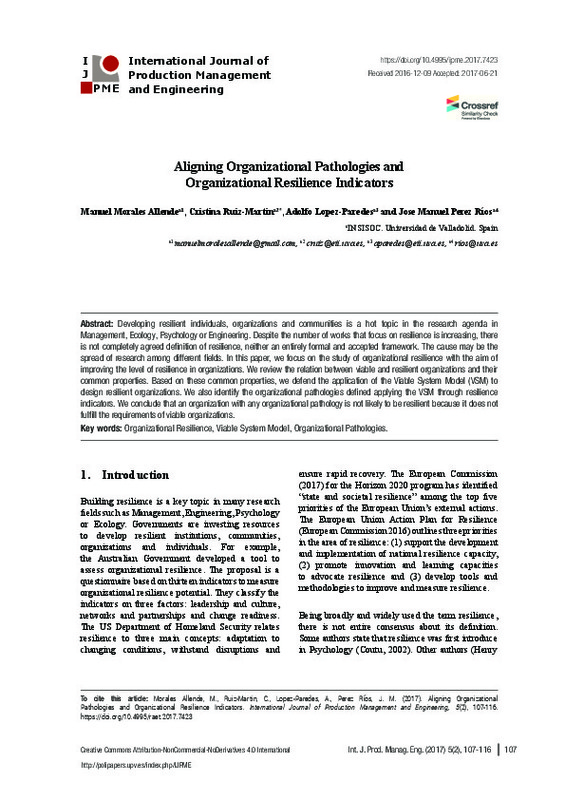Annarelli, A., & Nonino, F. (2016). Strategic and operational management of organizational resilience: Current state of research and future directions. Omega, 62, 1-18. doi:10.1016/j.omega.2015.08.004
Beer, S. (1981). Brain of the firm: the managerial cybernetics of organization, J. Wiley New York.
Bhamidipaty, A., Lotlikar, R., & Banavar, G. (2007). RMI: A Framework for Modeling and Evaluating the Resiliency Maturity of IT Service Organizations. IEEE International Conference on Services Computing (SCC 2007). doi:10.1109/scc.2007.94
[+]
Annarelli, A., & Nonino, F. (2016). Strategic and operational management of organizational resilience: Current state of research and future directions. Omega, 62, 1-18. doi:10.1016/j.omega.2015.08.004
Beer, S. (1981). Brain of the firm: the managerial cybernetics of organization, J. Wiley New York.
Bhamidipaty, A., Lotlikar, R., & Banavar, G. (2007). RMI: A Framework for Modeling and Evaluating the Resiliency Maturity of IT Service Organizations. IEEE International Conference on Services Computing (SCC 2007). doi:10.1109/scc.2007.94
Biggs, D., Hall, C. M., & Stoeckl, N. (2012). The resilience of formal and informal tourism enterprises to disasters: reef tourism in Phuket, Thailand. Journal of Sustainable Tourism, 20(5), 645-665. doi:10.1080/09669582.2011.630080
Coutu, D.L. (2002). How resilience works. Harvard business review, 80(5), 46-56.
Doe, P.J. (1994). Creating a resilient organization. Canadian Business Review, 21: 22.
Erol, O., Henry, D., Sauser, B., & Mansouri, M. (2010). Perspectives on measuring enterprise resilience. 2010 IEEE International Systems Conference. doi:10.1109/systems.2010.5482333
Erol, O., Mansouri, M., & Sauser, B. (2009). A framework for enterprise resilience using service oriented architecture approach. 2009 3rd Annual IEEE Systems Conference. doi:10.1109/systems.2009.4815785
Gilly, J.-P., Kechidi, M., & Talbot, D. (2014). Resilience of organisations and territories: The role of pivot firms. European Management Journal, 32(4), 596-602. doi:10.1016/j.emj.2013.09.004
Hamel, G., Valikangas, L. (2003). The quest for resilience. Harvard business review, 81(9): 52–65.
Henry, D., & Ramirez-Marquez, J. E. (2010). 3.1.1 A Generic Quantitative Approach to Resilience: A Proposal. INCOSE International Symposium, 20(1), 291-301. doi:10.1002/j.2334-5837.2010.tb01071.x
Holling, C. S. (1973). Resilience and Stability of Ecological Systems. Annual Review of Ecology and Systematics, 4(1), 1-23. doi:10.1146/annurev.es.04.110173.000245
Hollnagel, E. (2010). How Resilient Is Your Organisation? An Introduction to the Resilience Analysis Grid (RAG). Sustainable Transformation: Building a Resilient Organization.
Horne III, J.F., Orr, J.E. (1998). Assessing behaviors that create resilient organizations. Employment Relations Today, 24(4): 29–39.
Jackson, S. (2007). A multidisciplinary framework for resilience to disasters and disruptions. Journal of Integrated Design and Process Science, 11(2): 91–108.
Kendra, J. M., & Wachtendorf, T. (2003). Elements of Resilience After the World Trade Center Disaster: Reconstituting New York City’s Emergency Operations Centre. Disasters, 27(1), 37-53. doi:10.1111/1467-7717.00218
Lee, A. V., Vargo, J., & Seville, E. (2013). Developing a Tool to Measure and Compare Organizations’ Resilience. Natural Hazards Review, 14(1), 29-41. doi:10.1061/(asce)nh.1527-6996.0000075
Lengnick-Hall, C. A., Beck, T. E., & Lengnick-Hall, M. L. (2011). Developing a capacity for organizational resilience through strategic human resource management. Human Resource Management Review, 21(3), 243-255. doi:10.1016/j.hrmr.2010.07.001
Linnenluecke, M. K., Griffiths, A., & Winn, M. (2011). Extreme Weather Events and the Critical Importance of Anticipatory Adaptation and Organizational Resilience in Responding to Impacts. Business Strategy and the Environment, 21(1), 17-32. doi:10.1002/bse.708
Mallak, L.A. (1997). How to build a resilient organization. In Proceedings of the Industrial Engineering Solutions 1997 Conference. Miami, 170–177.
Manyena, S. B. (2006). The concept of resilience revisited. Disasters, 30(4), 434-450. doi:10.1111/j.0361-3666.2006.00331.x
Pérez Ríos, J. (2010). Models of organizational cybernetics for diagnosis and design. Kybernetes, 39(9/10), 1529-1550. doi:10.1108/03684921011081150
Righi, A. W., Saurin, T. A., & Wachs, P. (2015). A systematic literature review of resilience engineering: Research areas and a research agenda proposal. Reliability Engineering & System Safety, 141, 142-152. doi:10.1016/j.ress.2015.03.007
Ruiz-Martin, C., Pérez Rios, J. M., Wainer, G., Pajares, J., Hernández, C., & López-Paredes, A. (2017). The Application of the Viable System Model to Enhance Organizational Resilience. Advances in Management Engineering, 95-107. doi:10.1007/978-3-319-55889-9_5
Ruiz-Martin, C., Lopez-Paredes, A., Wainer, G. (2017). Organizational Resilience: Conceptualization and Measurement. Submitted.
Sanchis, R., & Poler, R. (2013). Definition of a framework to support strategic decisions to improve Enterprise Resilience. IFAC Proceedings Volumes, 46(9), 700-705. doi:10.3182/20130619-3-ru-3018.00600
Somers, S. (2009). Measuring Resilience Potential: An Adaptive Strategy for Organizational Crisis Planning. Journal of Contingencies and Crisis Management, 17(1), 12-23. doi:10.1111/j.1468-5973.2009.00558.x
Starr, R., Newfrock, J., Delurey, M. (2003). Enterprise Resilience: Managing Risk in the Networked Economy. Strategy and Business, 30: 70–79.
Tillement, S., Cholez, C., & Reverdy, T. (2009). Assessing organizational resilience: an interactionist approach. M@n@gement, 12(4), 230. doi:10.3917/mana.124.0230
R. Whitman, Z., Kachali, H., Roger, D., Vargo, J., & Seville, E. (2013). Short-form version of the Benchmark Resilience Tool (BRT-53). Measuring Business Excellence, 17(3), 3-14. doi:10.1108/mbe-05-2012-0030
[-]








